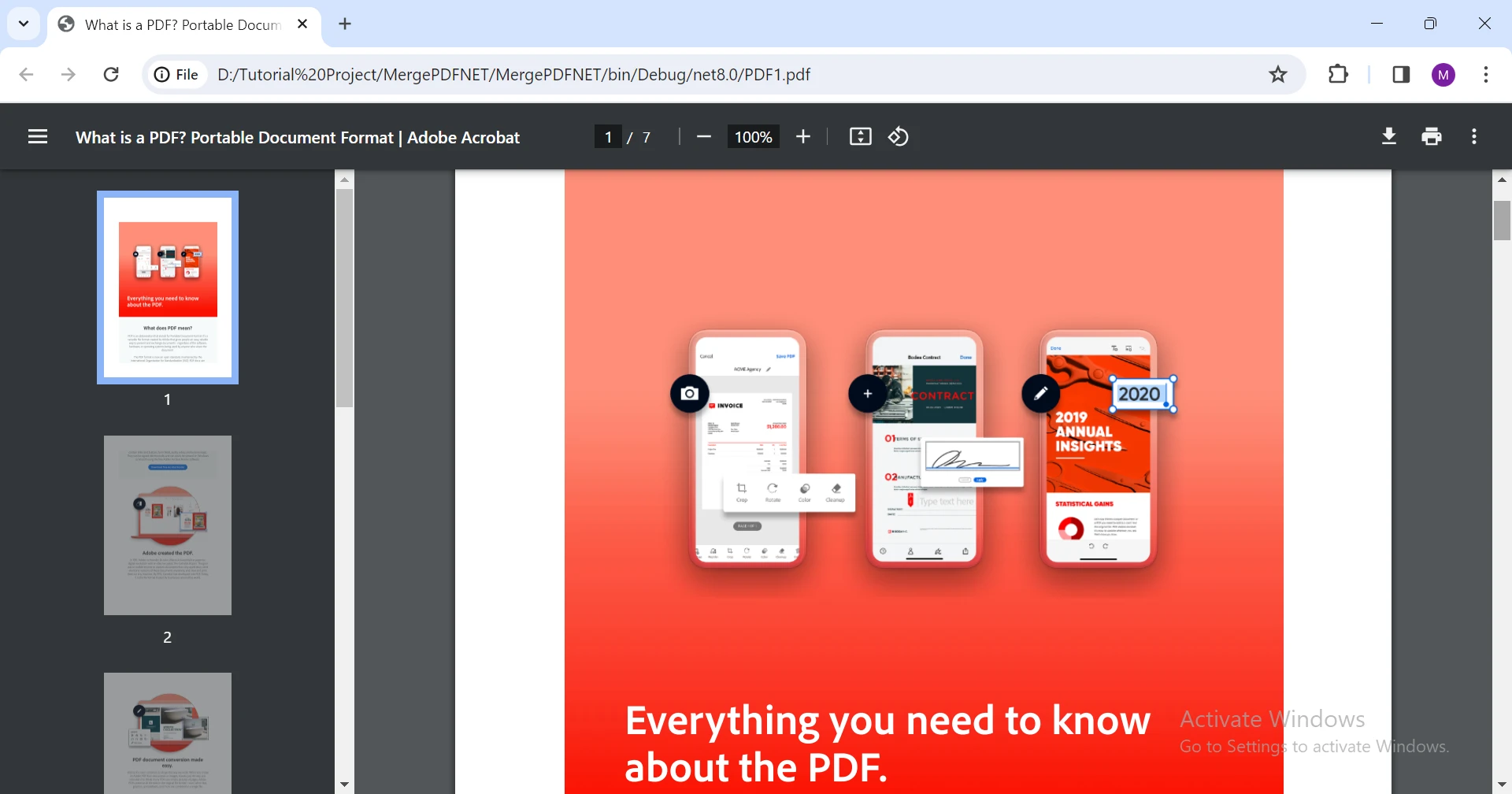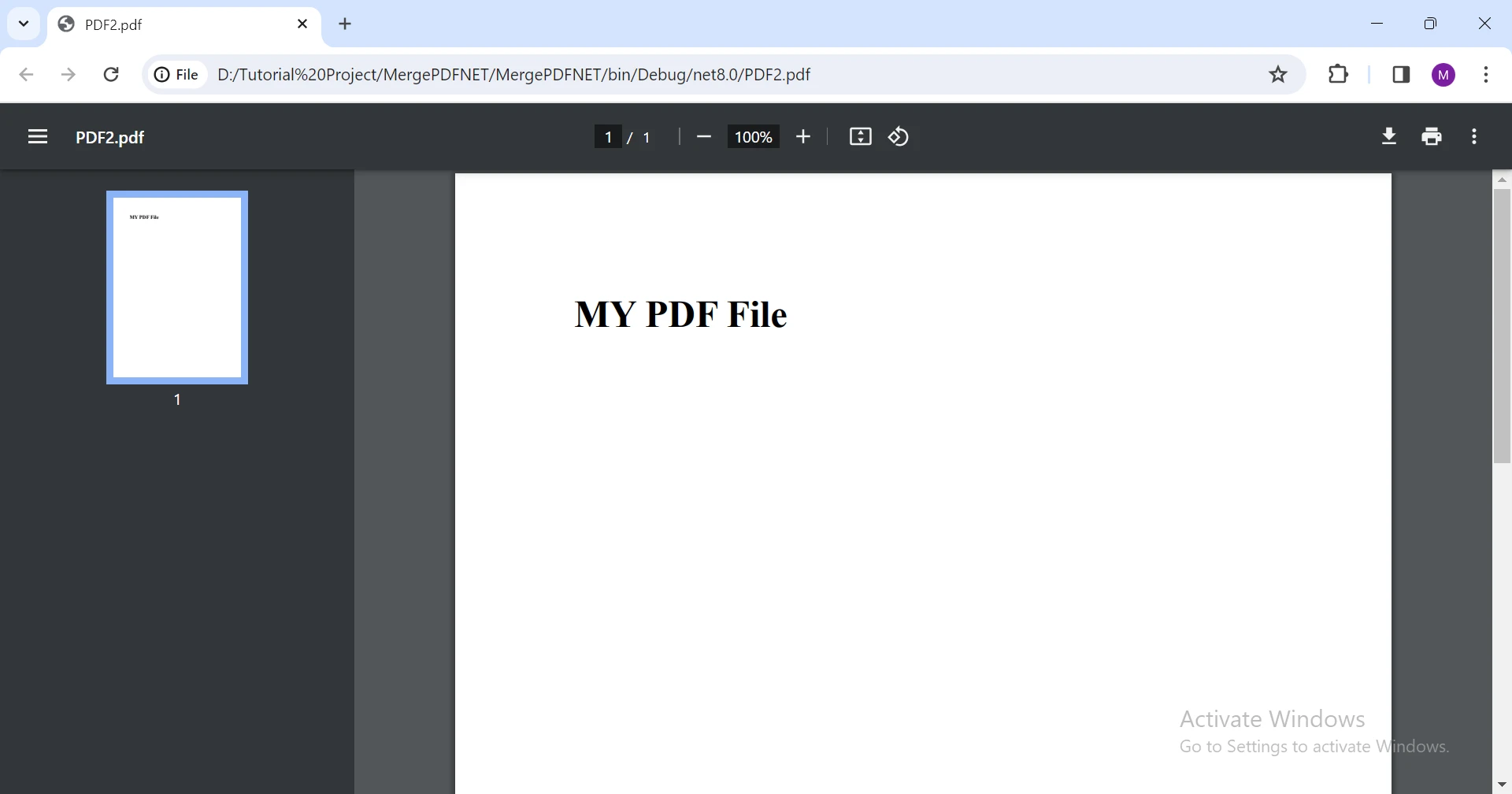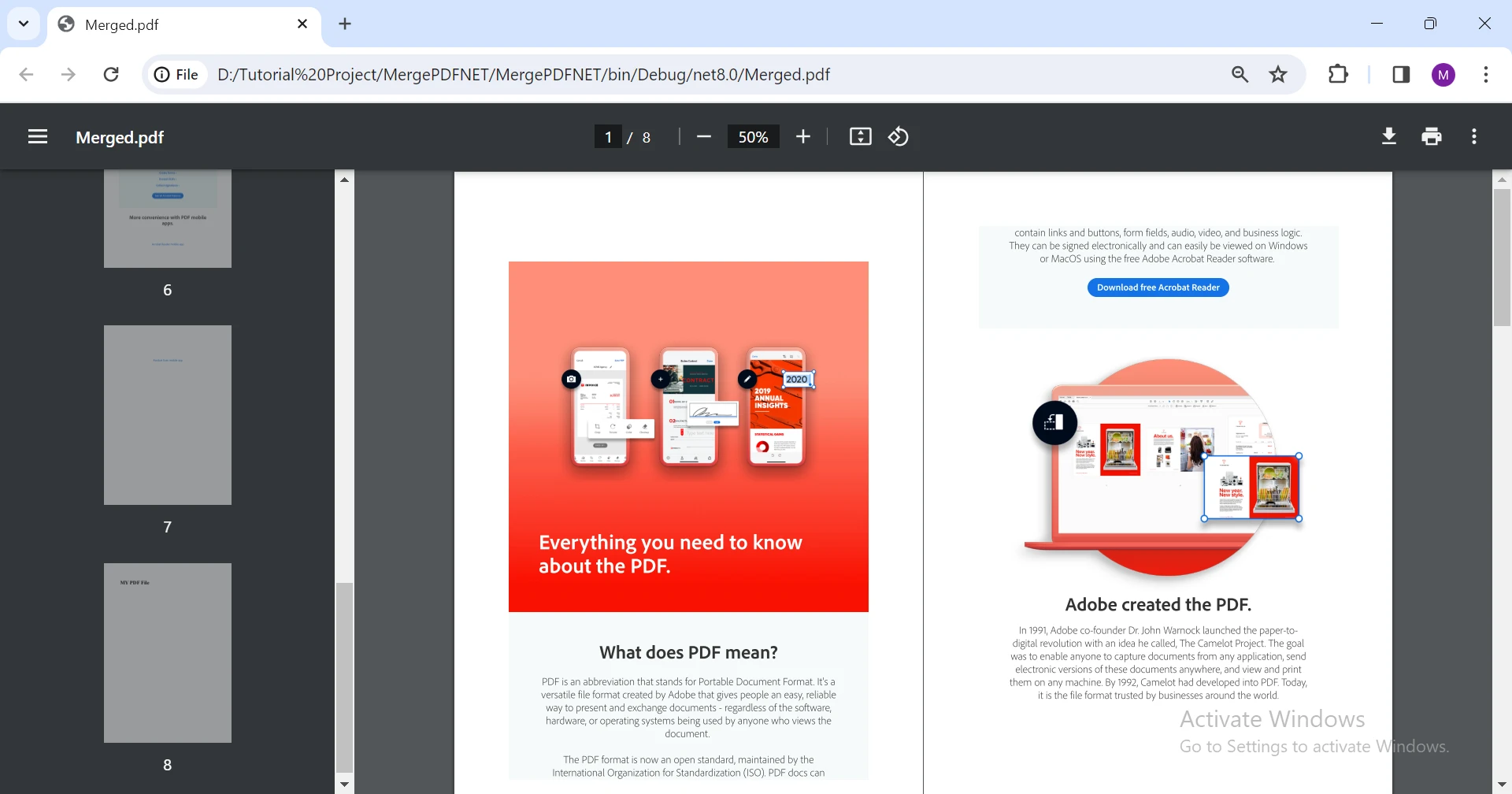Test in a live environment
Test in production without watermarks.
Works wherever you need it to.
The ability to merge PDF documents is a common requirement in many applications. Whether you are dealing with reports, invoices, or any other document-centric system, merging PDFs can streamline processes and enhance user experience. In the .NET ecosystem, IronPDF provides a powerful and flexible solution for working with PDF files. In this article, we will explore how to merge different PDF documents using IronPDF in a .NET application.
IronPDF is a .NET PDF library that allows you to generate and edit PDF documents from HTML, images, or other sources. It is compatible with .NET 8, 7, 6, 5, Core, Standard, and Framework, and supports various features such as encryption, compression, digital signatures, and OCR.
Some of the main features of IronPDF are:
You can convert HTML files, strings, or URLs to PDF documents, with support for CSS, JavaScript, images, fonts, and responsive layouts. You can also apply page templates, headers, footers, page numbers, and page breaks to customize the appearance of the PDF.
You can modify existing PDF documents by adding, deleting, or merging pages, changing metadata, applying passwords and permissions, adding digital signatures, and compressing the file size. You can also extract text, images, and form data from PDFs, or convert PDFs to HTML or images.
You can create PDF documents from scratch using the IronPDF, or use the PDFDocument class to manipulate PDF elements such as text, images, shapes, annotations, bookmarks, and forms. You can also use the PDFPrintOptions class to control the printing settings of the PDF.
Getting started with IronPDF is a breeze. Install the IronPDF NuGet Package into your .NET project using the NuGet Package Manager Console:
Install-Package IronPdf
Alternatively, you can directly install it from here.
Once IronPDF is installed, you can easily merge multiple PDF documents in your .NET application. Here's a step-by-step guide on how to do it:
We need an IronPDF License to use in our Project. You can get a free trial license from here.
IronPdf.License.LicenseKey = "IRONSUITE.ABC.XYZ.COM.876UTR-DEPLOYMENT.TRIAL-P45MXL.TRIAL.EXPIRES.31.JAN.2030"; // example of a license keyIronPdf.License.LicenseKey = "IRONSUITE.ABC.XYZ.COM.876UTR-DEPLOYMENT.TRIAL-P45MXL.TRIAL.EXPIRES.31.JAN.2030"; // example of a license keyIronPdf.License.LicenseKey = "IRONSUITE.ABC.XYZ.COM.876UTR-DEPLOYMENT.TRIAL-P45MXL.TRIAL.EXPIRES.31.JAN.2030" ' example of a license keyReplace this License key with the one you get from IronPDF.
Next, we need to open or create a new PDF document.
Begin by creating an IronPDF document for each PDF file you wish to merge. Whether you are dealing with existing PDFs or creating new ones, IronPDF makes the process seamless.
ChromePdfRenderer chromePdfRenderer = new ChromePdfRenderer();
PdfDocument pdfDocument = chromePdfRenderer.RenderUrlAsPdf("https://www.adobe.com/acrobat/about-adobe-pdf.html");
pdfDocument.SaveAs("PDF1.pdf");ChromePdfRenderer chromePdfRenderer = new ChromePdfRenderer();
PdfDocument pdfDocument = chromePdfRenderer.RenderUrlAsPdf("https://www.adobe.com/acrobat/about-adobe-pdf.html");
pdfDocument.SaveAs("PDF1.pdf");Dim chromePdfRenderer As New ChromePdfRenderer()
Dim pdfDocument As PdfDocument = chromePdfRenderer.RenderUrlAsPdf("https://www.adobe.com/acrobat/about-adobe-pdf.html")
pdfDocument.SaveAs("PDF1.pdf")The above code will create a new PDF file from the URL provided in the argument. It initializes a ChromePdfRenderer instance, which is part of IronPDF. It then uses this renderer to convert a web page (in this case, Adobe's PDF information page) into a PDF document and saves it as "PDF1.pdf." The RenderUrlAsPdf method allows seamless conversion of web content into a downloadable PDF file using the Chrome browser engine.
The generated PDF document is as:

IronPDF Provides three ways to Create a new PDF document:
Let's Create a Second PDF File from HTML String:
ChromePdfRenderer chromePdfRenderer = new ChromePdfRenderer();
PdfDocument pdfDocument = chromePdfRenderer.RenderHtmlAsPdf("<h1>MY PDF File</h1>");
pdfDocument.SaveAs("PDF2.pdf");ChromePdfRenderer chromePdfRenderer = new ChromePdfRenderer();
PdfDocument pdfDocument = chromePdfRenderer.RenderHtmlAsPdf("<h1>MY PDF File</h1>");
pdfDocument.SaveAs("PDF2.pdf");Dim chromePdfRenderer As New ChromePdfRenderer()
Dim pdfDocument As PdfDocument = chromePdfRenderer.RenderHtmlAsPdf("<h1>MY PDF File</h1>")
pdfDocument.SaveAs("PDF2.pdf")The above code will generate a new PDF document from the HTML String provided in the RenderHTMLAsPDF() method.
The Output PDF File is as:

Now, that we have both PDFs ready, let's write the code for merging PDF Files.
Now that you have individual PDF documents, you can merge them into a single PDF document using IronPDF.
PdfDocument pdfDocument1 = new PdfDocument("PDF1.pdf");
PdfDocument pdfDocument2 = new PdfDocument("PDF2.pdf");
var merged = PdfDocument.Merge(pdfDocument1, pdfDocument2);
merged.SaveAs("Merged.pdf");PdfDocument pdfDocument1 = new PdfDocument("PDF1.pdf");
PdfDocument pdfDocument2 = new PdfDocument("PDF2.pdf");
var merged = PdfDocument.Merge(pdfDocument1, pdfDocument2);
merged.SaveAs("Merged.pdf");Dim pdfDocument1 As New PdfDocument("PDF1.pdf")
Dim pdfDocument2 As New PdfDocument("PDF2.pdf")
Dim merged = PdfDocument.Merge(pdfDocument1, pdfDocument2)
merged.SaveAs("Merged.pdf")The above code creates two PdfDocument instances, pdfDocument1 and pdfDocument2, by loading existing PDF files ("PDF1.pdf" and "PDF2.pdf"). The PdfDocument.Merge method is then used to combine these two input PDF files into a single merged document, and the result is saved as "Merged.pdf." This demonstrates how IronPDF simplifies the process of merging existing PDFs into a consolidated file in a few lines of code. In this way, we can easily merge multiple PDF files very easily.
The merged PDF document is as:

In conclusion, the process of merging multiple PDF documents in a .NET application becomes remarkably straightforward with the use of IronPDF. This powerful library not only simplifies the merging of PDFs but also offers amazing features for PDF generation, editing, and manipulation. From converting HTML to PDF with advanced styling options to seamlessly merging existing PDFs, IronPDF proves to be a versatile tool in the developer's toolkit.
By following the steps outlined in this guide, developers can effortlessly integrate IronPDF into their projects, taking advantage of its capabilities to enhance document-centric applications. Whether you are dealing with reports, invoices, or any other document type, IronPDF's features, including the ability to append, delete, or modify pages, make it an invaluable asset. Additionally, the library's compatibility with various .NET frameworks ensures its applicability across a wide range of projects.
IronPDF is easy to install and use and provides comprehensive documentation and examples to help you get started with PDF development in C#. It offers various licensing options, along with a free trial, depending on the number of developers, locations, projects, and redistribution needs. The licenses are perpetual and include free support and updates.
9 .NET API products for your office documents








